Andor’s large area iKon-XL and -L back-illuminated CCD cameras represent ideal solutions for exoplanet science, due to the sensor’s high sensitivity and high QE coverage (>90% peak QE) in combination with a low noise floor supporting high precision photometry. Sensor options for extended NIR performance (‘BEX2-DD’ and ‘BR-DD’) allow for the detection of small planets orbiting cool stars (see Fig. 1). Furthermore, the iKon-XL and -L are perfectly suited for usage in remote observing sites, thanks to the unique Andor UltraVac™ vacuum thermoelectric cooling technology, enabling superb sensor longevity and avoiding the need for vacuum re-pumping.
| Exoplanet Discovery Requirement | Exoplanet Discovery Solution: iKon-XL and iKon-L |
| Probe stellar photometric variability in a large area of sky | iKon-XL is a 16.8 Megapixel camera platform, integrating the e2v CCD231-84 and CCD230-84 devices. iKon-L is a 4.2 Megapixel camera platform, integrating the e2v CCD42-40 device. Both sensors can support large field of views, allowing to search for exoplanet hosting stars in a greater area of sky. |
| High precision photometry | Both iKon-XL and iKon-L combine 95% peak QE with low read noise (slow-scan) and -100 °C vacuum TE cooling for dark noise minimization, even over long acquisition periods. |
| Observe faint and bright objects | The unique Extended Dynamic Range technology (18-bit) of the iKon-XL allows measuring signals of faint and bright stars simultaneously. |
| Detect planets orbiting cool stars | Due to the extended NIR sensitivity options available for both the iKon-XL and -L, cool stars, such as M-dwarfs, can be probed, which would otherwise be too faint in the visible part of the spectrum (see Fig. 1). |
| Low maintenance and minimal downtime of cameras | iKon-XL and iKon-L are perfectly architected for sustained usage in remote observing locations. The proprietary UltraVac™ permanent vacuum sensor enclosure (no re-pumping!) affords the ultimate in performance longevity. The thermoelectric cooling capability avoids need for LN2 or unreliable cryo-coolers. iKon-XL also comes with a field replaceable shutter unit. |

Fig. 1 Quantum efficiency curves of the standard Silicon (‘BV’) and deep depletion (‘BR-DD’ and ‘BEX2-DD’) iKon-L sensor options. The figure additionally shows the peak wavelengths λmax of the Sun and the exoplanet hosting M-dwarf GJ 1132, assuming effective temperatures of 5778 K and 3270 K, respectively. It highlights the higher quantum efficiency in the NIR using deep depletion sensors, which is of great importance for observations of cool stars, such as M-dwarfs.









